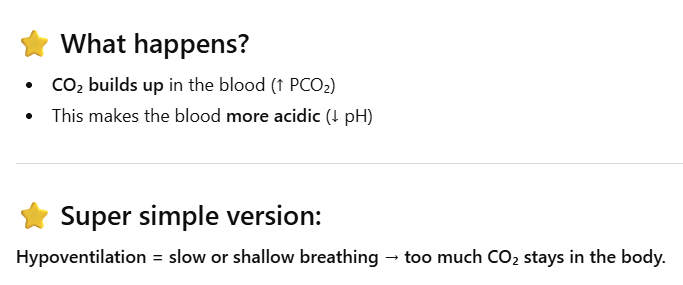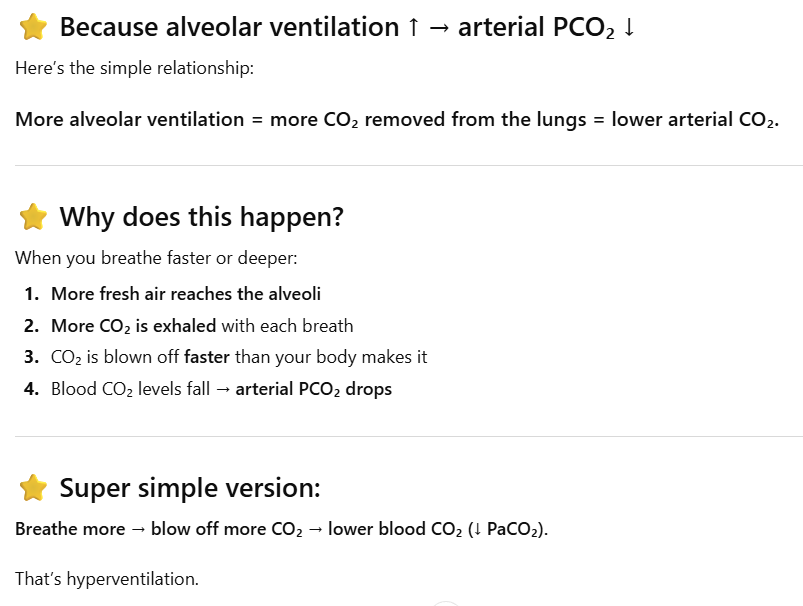L45 | Gas Exchange
1/16
There's no tags or description
Looks like no tags are added yet.
Name | Mastery | Learn | Test | Matching | Spaced |
|---|
No study sessions yet.
17 Terms
Where does gas exchange occur within lung?
diffusion between air in alveoli and blood in pulmonary capillaries
O2 diffuses into pulmonary capillaries
CO2 diffuses into alveoli
Where does gas exchange occur within systemic tissues?
diffusion between gases in blood in systemic capillaries and surrounding cells
O2 diffuses → tissues
CO2 diffuses → systemic capillaries.
What is minute ventilation (VE)?
volume of air moved into respiratory system each minute
Why doesn’t all the air that is moved into the respiratory system reach the respiratory zone?
because we have TIDAL BREATHING (air comes in & then goes out from same pathway) & a conducting zone.
What is alveolar ventilation (VA)?
volume of air moved into respiratory zone (site of gas exchange) each minute
Alveolar Ventilation (VA) is always __________ Minute Ventilation (VE) because of __________________
Alveolar Ventilation (VA) is always less than Minute Ventilation (VE) because of anatomical dead space (VD).
What is barometric pressure (atmospheric pressure) comprised of?
N2 (79%), O2 (21%), & CO2 (0.04%)
Barometric pressure ___________ as elevation increases
Barometric pressure decreases as elevation increases
Partial pressure individual gas = ___________________ x ____________
Partial pressure is indicated by “P” before gas: i.e. PO2
Partial pressure individual gas = total pressure (mmHg) x (% of gas in mixture)
Partial pressure is indicated by “P” before gas: i.e. PO2
How does gas exchange happen during breathing?
Every breath fills the alveoli with fresh air → increases O₂ partial pressure
Because O₂ pressure is higher in alveoli than in blood, O₂ diffuses into the blood
Because CO₂ pressure is higher in blood than in alveoli, CO₂ diffuses into the alveoli
How does alveolar ventilation change Alveolar O₂ and CO₂?
alveolar ventilation INCREASES alveolar PO2
Arterial PO2 will increase as alveolar PO2 increases
alveolar ventilation DECREASES alveolar PCO2
Increase alveolar ventilation → ↑ PO₂ and ↓ PCO₂
Decrease alveolar ventilation → ↓ PO₂ and ↑ PCO₂
Why will PAO2 will never exceed 150 mmHg?
PO2 OF HUMIDIFIED, INSPIRED AIR = 150 mmHg
______________ PO2 & PCO2 Determine __________ PO2 & PCO2
Alveolar PO2 & PCO2 Determine Arterial PO2 & PCO2
What is hypoventilation?
LESS CO2 expired (exhaled) than produced in tissues
decrease in alveolar ventilation (VA) sufficient to increase arterial PCO2 ABOVE its normal range.
Decrease gradient between mixed venous blood & alveoli
Less diffusion of CO2 out of pulmonary capillaries
PaCO2 increases → hypercapnia/hypercarbia (increase arterial PCO2)

What is hyperventilation?
MORE CO2 expired (exhaled) than produced in tissues
increase in alveolar ventilation (VA) sufficient to decrease arterial PCO2 BELOW its normal range.
Increase gradient between mixed venous blood & alveoli
More diffusion of CO2 out of pulmonary capillaries
PaCO2 decreases → hypocapnia/hypocarbia (decrease arterial PCO2)

What are the changes in arterial blood gases during hypoventilation?
↑ PaCO₂ and ↓ PaO₂
What are the changes in arterial blood gases during hyperventilation?
↓ PaCO₂ and ↑ PaO₂